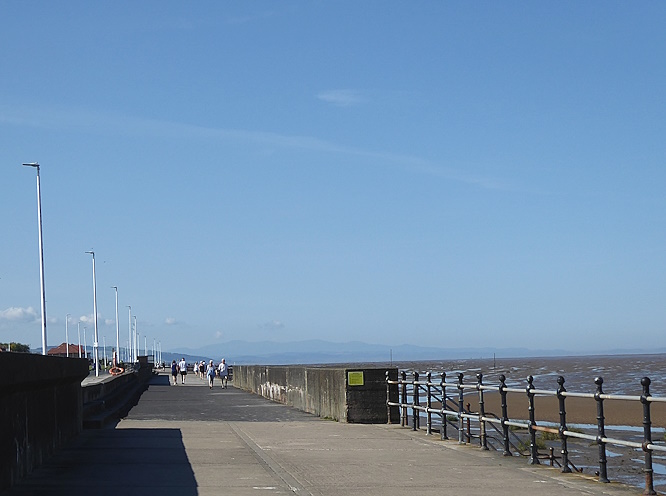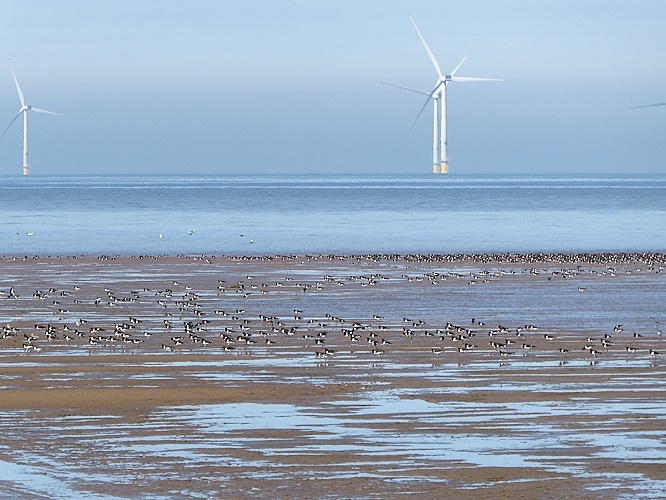
Meols pronounced “Mells” is a village on the north Wirral coast, once a Viking settlement. From the station we walked along Dovepoint Road, Park Road (past a house claiming to have been built in 1649), and down Bennetts Lane to the shore. Interesting garden trees on the way included some heavily-fruiting Crab Apples and an amazing pair of Beech trees, clipped almost to unrecognisability. How much effort must THAT take?

From the start of Meols Parade it is a two-mile walk south westwards to Hoylake. It overlooks an expanse of sand on the north coast of Wirral and out to the wind turbines in Liverpool Bay. The Mersey estuary was behind us and the Dee Estuary in front. High tide was due at 1.15 and it was very warm and sunny. The sand was scattered with birds. Very many Herring Gulls and Black-headed Gulls, two Greater Black-backed Gulls, many Redshank, large flocks of Oystercatchers and some Curlews. A Raven flew overhead towards Liverpool. Two Black-tailed Godwits circled then headed off. Some Carrion Crows were keeping watch from high vantage points. Two Little Egrets hunted by the pools, this one showing off its yellow feet.

TheHoylake Lifeboat hovercraft came out and patrolled the sand, perhaps making sure no walkers or fishermen were in danger at the water’s edge, because the tide flows in very fast over these shallow sands.

We lunched in Meols Parade Gardens, which was sheltered and very warm in the sun. Several very active butterflies were flitting over the Valerian and other flowers – Red Admirals, Small Tortoiseshells and Small Whites. There were also lots of bumble bees, some looking like quite big ones.
Even around high tide, the water didn’t come right up to the promenade, but large flocks of Oystercatchers had to walk quite fast to keep ahead of the advancing tongue of water.

Signs along the sea wall put up by the Dee Estuary Volunteer Wardens described some of the “Wonderful Waders” and included a polite request to keep control of dogs near to high tide when the birds come near.

But there are always some who don’t heed. Several dogs were running out to the flocks of birds, or frolicking in the shallows. To our horror, one loose dog near the lifeboat station plunged into a small group of Oystercatchers and after much flapping and splashing caught one. The young man who was the dog’s owner was calling “Arthur! Arthur!” to no effect. The dog eventually dropped the bird and came to heel, but the bird was a goner.

As we neared Hoylake we could see that Hilbre Island and Middle Eye were surrounded with water.

The Spartina grass that has been spreading along the sand has made a dry grassy area there, and people were picnicking and sunbathing. Other local residents are furious that the council isn’t sending machines to dig it all out, Canute-like, and they have banners up outside their houses. It isn’t all bad, because the new land is providing habitat for non-waders like Pied Wagtails and Rock Pipits. But I was surprised at how fast it has spread. The grassy area goes as far as King’s Gap, and it feels like only a year or two ago there was sand right up to the sea wall there.
In Hoylake Village the municipal flower holders along the road were golf bags, in homage to the Royal Liverpool Golf Club, where The Open took place in July.

Public transport details: West Kirby train from Central at 10.05, arriving Meols 10.30. Returned on the train from Hoylake at 2.34, arriving Central 3.08.
